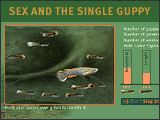| Have you ever wondered why many birds
and fishes are brightly colored? Doesn't that make these animals
more vulnerable to predators? You will examine these questions
while conducting a simulation
of the impacts of predation on a wild guppy population. The
simulation
is based on Dr. John Endler's now famous research on the evolution of
various
characteristics of guppies. You read a little about Dr.
Endler's
work in your assigned reading. If you are interested, the
original
manuscript of his research on guppy evolution is available at : Natural
Selection on Color Patterns on Poecilia reticulata.
As you work through the simulation, be
sure to visit all links. You will learn more from this activity
if you
become familiar with the various color morphs that occur in guppies and
the different fishes that predate on guppies. Once you have
looked
over the guppy, predator, and habitat information then you are ready to
conduct the simulation itself.
Before running the simulation,
answer questions #1 and #2 on your workheet. Then click on the
icon below.
Select Activity, "Flashy Fish" and run the simulation once using the
settings
currently in place and become familiar with the program. Now, go
back
to your data sheet and write a hypothesis for item #3 and a prediction
of
the outcome you expect if your hypothesis is supported. Proceed
to
complete the work sheet. Based on the results of your first
experiment,
state a new hypothesis and prediction for item # 6 (even if your first
hypothesis was supported). Remember, the objective of this
activity is
to help you understand how selection acts to cause change in
populations. Make sure that you demonstrate your understanding of
natural selection when you explain why your hypotheses and
prediction(s) were supported
or rejected (items #6 and 8). In particular, make sure that your
understand
of the effects of sexual selection AND selction for cryptic coloration
is
clear in your explanations. Turn in your work sheet before
leaving
class.

|




